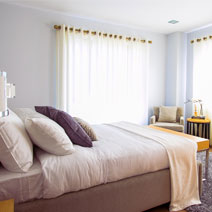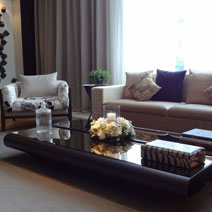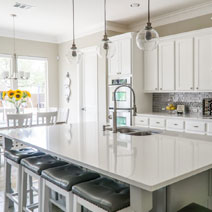KITCHEN COUNTERTOPS
There are basically 2 categories for kitchen countertop application. These are LAMINATE and SOLID SURFACE. Note: There are MANUFACTURERS of materials used in fabrication of tops, then FABRICATORS who fashion the materials into tops and RETAILERS who sell the finished products. Understanding these relationships makes searching out clear and concise educational information less confusing.
LAMINATE
Laminates are constructed with multiple layers of craft paper, capped with a photographic rendering, and then sealed beneath a melamine wear layer. Different wear layers can provide different surface finishes. Examples are: high gloss, matte, stone, etched, satin and textured surfaces. The maximum laminate sheet size available is 5’x 12’. The brown edge, or “line” visible around the perimeter of a “self-edge” laminate top is the layers of craft paper. Laminates are nonporous, but not knife or heat resistant.
Laminate is applied over a wooden substrate. The substrate is vulnerable at seams and edges when exposed to water. A common failure point is behind the faucet at the junction with the backsplash. The substrate that most laminates are applied to is a high density particleboard that will swell when exposed to moisture. Laminate wear layers can be compromised with abrasive cleansers. Once the wear layer has been compromised stains can easily permeate the photographic presentation. If the photographic visual is compromised there is no repair.
Within laminate tops are 2 basic options: self-edge (traditional square edge) and post-form.
A. Self-edge tops glue the flat laminate sheet over all flat surfaces creating a sharp square edge profile. This square edge exposes the typical brown line. Self-edge tops may be built with applied custom edges. These can be a bevel edge, ogee, or a slightly curved profile thus eliminating the sharp square edge profile and hiding the brown edge line. Note: There are limited laminate color palettes that offer custom edge profiles. Self-edge tops may be fabricated in nearly unlimited shapes and sizes, however custom edge profiles cannot wrap a radius corner.
B. Post form tops are manufactured in only specific lengths and depths. The laminate is wrapped around the long edges under heat and pressure. This eliminates the brown line on long edges. Very commonly the back splashes are also included into the wrap eliminating the common faucet to backsplash failure zone. Post-Form tops are limited to 12’ lengths. There are only a few different depths and edge configurations available. Miters must be cut for an “L” shaped counter. Short ends must be capped showing the aforementioned brown line found in self edge tops. Virtually all tops must be constructed with straight lines as post-form tops are only manufactured in straight lengths.
Laminate is easily less than half the cost of solid surface tops.
SOLID SURFACE
This category includes most any product where the surface and core of the product is one. Although wood, stainless steel and concrete may fit that definition, most commonly this category refers to GRANITE, QUARTZ and ACRYLIC. Different edge profiles are carved into the solid surface to provide different styles. Seaming if needed is usually accomplished with an epoxy or acrylic resin.
GRANITE is a naturally occurring stone cut from the earth into a slab and fabricated for countertop application. It is heat and knife resistant but it is porous. It is easily sealed with a wipe on sealer. Because granite is porous it is approved for use in restaurant food service areas, but generally not in food preparation areas. Rarity and accessibility of different colors of stone is what drives the pricing of different Granites. Note: Quartz is a naturally occurring stone that can be mined in slabs and fabricated just like Granite. This quartz is often confused with quartz tops. It is recommended that granite slabs be personally selected as color shade variations abound.
QUARTZ tops are real ground stone “most often quartz” artistically manipulated and held together with an acrylic resin. Quartz products are heat and knife resistant as well as being nonporous. Quartz products offer a deep palette of color in myriad configurations. Samples of Quartz products generally provide the consumer with a true visual of the product which greatly reduces the need to select individual slabs. Quartz is nonporous so it is generally approved in food preparation or service areas.
ACRYLIC is a synthetic polymer. “Corion” is to acrylic, what “Kleenex is to facial tissue”. Some other manufacturers include Swanstone, Hi Macs, Avonite, and Staron. Acrylic tops are nonporous, but can be scratched with knives and are not highly heat resistant. They offer a wide variety of color and can readily be fabricated into unlimited shapes and sizes. Splashes and sinks can be integrated into the top. Integrated means that they can be fused together into one piece versus just attached together with an adhesive.
A Note on SINKS:
Any countertop may use a "drop in" sink where a hole is cut and the sink simply “drops into” the hole. With drop in sinks, the sink provides the pretty edge adjoining the top. The preventative water leakage measure (between the sink perimeter and the countertop) is usually a silicone caulk. The sinks can be of any material. Laminated tops traditionally use only drop in sinks. I won't discuss it here, but there are some exceptions to every rule.
Most Solid surface tops employ an "under mounted" sink where the hole for the sink needs to be precisely cut and finished, as it is readily visible. The sink is “mounted under” the working surface. Under mounting eliminates the visible caulked edge and the crumb barrier that is inherent with drop in sinks. Under mount sinks are available in many materials.
"Integrated" sinks can be created by fusing acrylic sinks into one piece with an acrylic counter.
CULTURED MARBLE VANITY TOPS
Although any bath vanity top can be created using any of the aforementioned methods, there is another category called cultured marble. Cultured marble is a blend of stone particles and resins poured into a mold. When cured, it is removed from the mold and finished with a gel coat. Because these are produced in molds, integrated sinks are commonplace but, the molds also limit the overall sizes available. The gel coat finish is nonporous but, not heat resistant and can be damaged with abrasive cleaners. These tops are not recommended for kitchen applications.


















